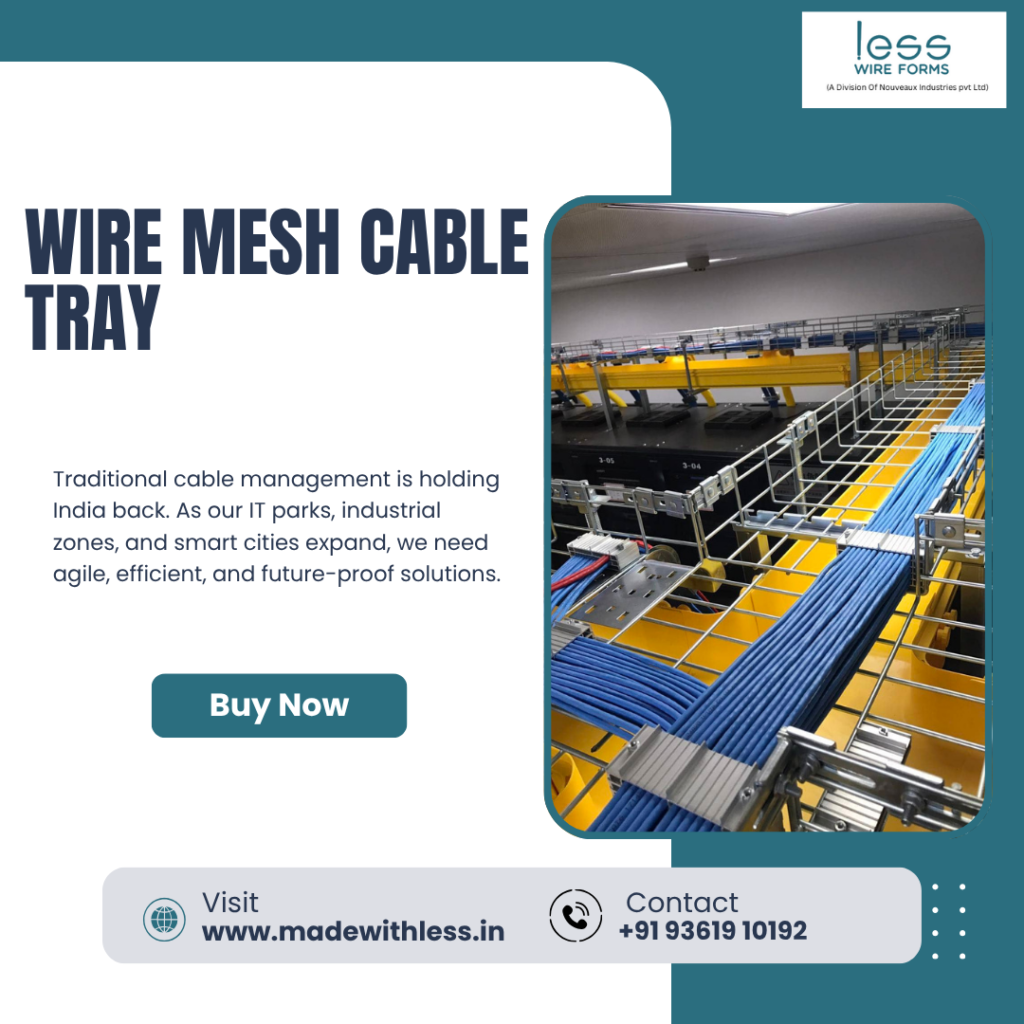In the bustling landscape of modern India, from the gleaming IT parks of Bengaluru and Hyderabad to the rapidly expanding industrial corridors and smart city projects, one critical challenge unites them all: efficient and safe cable management. For decades, traditional sheet metal or ladder trays were the default choice. But a quiet revolution is underway, and at its heart is a simple, yet profoundly effective solution—the Wire Mesh Cable Tray.
This isn’t just an incremental upgrade; it’s a paradigm shift. Let’s explore how this versatile technology is transforming the way India manages its power, data, and communication lifelines.
The “Achilles’ Heel” of Traditional Cable Trays
Before we dive into the solution, let’s understand the problem with conventional systems:
- Poor Ventilation: Solid-bottom trays can trap heat, leading to overheating of cables and reduced efficiency and lifespan.
- Weight & Corrosion: Heavy-gauge steel trays are cumbersome to install and prone to rust in India’s diverse and often humid climates.
- Inflexibility: Any change in cable routing or addition of new cables often requires a complete overhaul of the tray system.
- Visual Clutter: It’s difficult to identify specific cables, making troubleshooting a time-consuming nightmare.

Enter the Hero: The Wire Mesh Cable Tray
A wire mesh cable tray is a basket-like structure made from high-tensile steel wires welded together to form a robust, open grid. This simple design is the source of its revolutionary power.
Why Wire Mesh Trays are a Game-Changer for India
1. Unmatched Flexibility & Scalability
India’s growth is dynamic. Offices expand, factories add new production lines, and data centers scale up overnight. Wire mesh trays are the perfect partner for this growth.
- Easy Modifications: Need to add a power line for a new server rack or a data cable for a new office wing? Cables can be added or removed from any point without dismantling the entire run.
- On-Site Adaptability: The trays can be easily cut, bent, or shaped on-site to navigate around obstacles, a common challenge in complex Indian construction sites.
2. Superior Heat Dissipation
In a country where high ambient temperatures are the norm, preventing cable overheating is crucial. The open-mesh design allows for maximum airflow around the cables, naturally dissipating heat. This enhances safety, improves cable performance, and can even lead to energy savings by reducing resistance.
3. Exceptional Visibility for Easy Troubleshooting
For IT managers and maintenance engineers, time is money. The open design provides complete visibility of every cable throughout the entire run. Identifying a faulty cable, tracing its path, or performing routine audits becomes a quick and simple task, drastically reducing downtime.
4. Lightweight Yet Incredibly Strong
Don’t let the lightweight nature fool you. Made from high-quality steel, these trays have an excellent strength-to-weight ratio.
- Easier Installation: They are lighter and easier to handle, reducing labor costs and installation time—a significant advantage in fast-track projects.
- Less Structural Load: The reduced weight puts less stress on building structures, an important consideration for high-rise buildings and retrofitting projects.
5. Durability and Corrosion Resistance
Modern wire mesh trays are typically finished with Galvanization (Zinc coating) or Powder Coating. This makes them highly resistant to rust and corrosion, ensuring a long service life even in the humid coastal climates of Mumbai or Chennai, or the polluted industrial atmospheres.
6. Cost-Effectiveness in the Long Run
While the initial investment might be comparable, the Total Cost of Ownership (TCO) of wire mesh trays is often lower. Savings are realized through:
- Reduced installation time and labor.
- Minimal maintenance costs.
- Elimination of future retrofit expenses due to inherent flexibility.
Where is India Adopting Wire Mesh Cable Trays?
The applications are vast and growing:
- IT & ITeS Sector: Data centers, server rooms, and office campuses where cable changes are frequent.
- Smart Cities & Infrastructure: For managing the complex web of CCTV, traffic signals, and public Wi-Fi cables.
- Manufacturing & Industrial Plants: In factories where machinery is often reconfigured, requiring flexible power and control cable management.
- Healthcare: Modern hospitals with advanced medical equipment need clean, organized, and easily accessible cable pathways.
- Commercial Real Estate: Malls, airports, and high-rise buildings benefit from the aesthetic and functional advantages.
The Future is Organized and Agile
The shift towards wire mesh cable trays is more than just a trend; it’s a recognition that India’s infrastructure needs to be as agile and future-proof as its ambitions. It aligns perfectly with the nation’s focus on “Make in India,” with several domestic manufacturers now producing high-quality trays that meet international standards.
By choosing wire mesh cable trays, Indian businesses and projects are not just organizing cables; they are investing in a system that promotes safety, efficiency, and scalability—the very pillars of sustainable growth.
